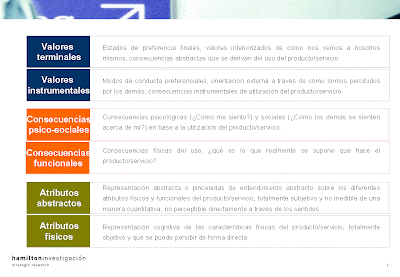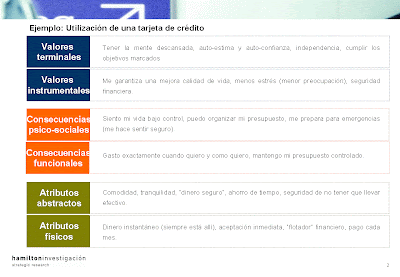There are some methodologies that are not used enough despite the high strategic value they generate. Halfway between qualitative and quantitative analysis is laddering through the analysis of the “means-end” chain (which could be translated as “meanings and purposes”).
The “means-end” theory proposes to represent the existing connections between a product or service and an individual.
“Means” derives from the attributes generated by this product and service to the consequences, positive or negative, that are associated with its use.
“Ends” are the results of users' derived desires expressed in their own personal values.
Therefore, the “means-end” theory proposes three levels of abstraction of information through individuals' thoughts about a product or service:
Level 1 “Attributes” (A), consisting of defining the traits, physical characteristics and ingredients that make up a product in the most objective way possible. Used as pure descriptors of the product or service.
Level 2 “Consequences” (C), the result or benefit of using this product or service. It represents what the product “does” for the user,
Level 3 “Values” (V), the ultimate or true reason why a person uses a product or service, that is, how this product can help achieve an individual's vital objectives.
As we see, an LCA ranking occurs from the most concrete (attributes) to the most abstract (values), therefore, the “means-end” theory proposes an investigation where people move “up the ladder of abstraction” and therefore both show the values that really drive the preferences of individuals.
This “means-end” method represents the basis for the positioning strategy of the product or service and serves as a statistical basis to find consumer “insigths” by transferring attributes into values as the ultimate essence of product/service choice.
The levels of abstraction can be determined from 6 specific categories (advanced development of the three basic levels):
In a practical way, it is about obtaining a “Hierarchical Value Map” through different interviews (the sample should not exceed 50) to determine a “mapping” of attributes, consequences and values that results in the relational level of the consumer with the product. /brand.
This practical application can be developed for aspects of branding or brand analysis where we determine for a specific brand what attributes it provides, what consequences are obtained on these brands and what are the values (both instrumental and terminal) that are derived from the same.



